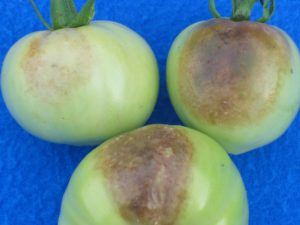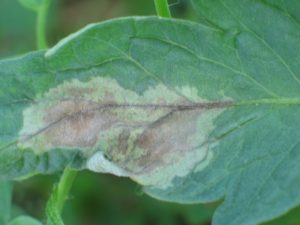Late Blight of Tomato and Potato in 2011: Watch for It and Participate in the New National Reporting System

The effect of late blight infestation on tomato fruit. Photo by Meg McGrath
Two unexpected finds of late blight on tomato in greenhouses in the northeast during April plus detections in seed potatoes expose an unfortunate but important fact – everyone growing tomatoes and potatoes in 2011 needs to expect and thus prepare for late blight occurrence in their plants.
Preparation is critical since late blight is a top contender for most difficult disease to manage once it has started.
The unsolved nature of the outbreaks this spring, as well as some outbreaks in 2010, reveals there is clearly a need to obtain a better understanding of the sources of the pathogen, especially for early season outbreaks. Knowledge of the sources will lead to targeted management practices and minimize the potential for growers being caught off guard. This can be accomplished through growers and researchers investigating occurrences together. Fortunately, there is now a team of researchers at 17 institutions, including Cornell, working as part of a national project with funding from the USDA. This project will address aspects of late blight and its management during the next five years. Activities will integrate extension, research, and education to help control the disease. These include systems for helping growers make management decisions, methods for identifying pathogen strains and their traits, and plant varieties that are more resistant.
There is also a need to know where late blight occurs throughout the growing season in order to study movement of the pathogen and develop a predictive system to enable growers to be more informed about potential outbreaks in the future. Thus it is important to report all occurrences. Success of this reporting system is dependent on growers participating in the National Reporting System.
Here’s how you can help! Routinely inspect plants for symptoms beginning at the start of production. Plants in high tunnels and greenhouses are now recognized to be vulnerable rather than fully protected. If you think you may have late blight, contact your local Extension office for verification of the diagnosis and submission of a sample to the national research team, which will initiate study of your outbreak. Information on how to sample is under ‘Reporting Outbreaks’ at the project web site. Samples are needed to determine the genotype of the pathogen responsible for the outbreak. You can stay informed about occurrences of late blight to gauge the potential threat to your crop by checking reports at the project web site, too. Information about late blight and its management is also being posted there.

Progression of the disease symptoms on tomato foliage. Photo by Meg McGrath
Some early-season outbreaks of late blight in tomato have raised concern that the new pathogen genotypes may have another means to survive between crops over winter in the north other than the only known means, which is in potato tubers. This concern was heightened following a recent report of late blight on volunteer tomatoes in a greenhouse with no apparent potatoes in the vicinity. This might reflect the fact a tomato genotype of the late blight pathogen being less aggressive on potato consequently does not produce as distinctive symptoms characteristic of a tuber infection. Without knowledge of the sources for the early-season outbreaks of late blight in tomato, there is concern that they will continue to occur, as we cannot effectively manage what we do not understand.
Understanding the Enemy – Phytophthora infestans, the causal agent of late blight in tomato and potato
- Identifying the disease – symptoms and pathogen life cycle
- To report an outbreak of late blight and submit samples, go to: usablight.org Your sample is important for a national project tracking and studying this important disease.
- Need to know where your local Cooperative Extension Office is to report an outbreak or get help with identification and sample submission? Click here for NY offices
- Maps of current late blight outbreaks and a late blight forecasting model
Map - Information on test kits for Phytophthora is available at Agadia. The test is recommended for use as a preliminary screening tool for Phytophthora species. Plant sap is placed on an indicator strip. If the sample is identified as late blight, please also submit plant samples to usablight.org.
- Late blight decision support tools from: Cornell University & NC State
-
- A photo gallery of late blight images and late blight ‘imitators’
- Late blight webinars for gardeners from Rutgers University
- Managing Late Blight in Tomato and Potato – An Essential Part of Gardening
- Late blight FAQs and corrections of misinformation
- Fungicide information for home gardeners.
Other Fact Sheets:
Others:
Vegetable MD On-line Fact Sheet on Late Blight of Tomatoes and Potatoes
NYS IPM Fact Sheet
Late Blight on Potatoes Factsheet
University of Massachusetts Fact Sheet
Managing Late Blight in Tomatoes – University of Wisconsin
For more information on Late blight, check the LIHREC website. To contact Dr. McGrath, call her at (631) 727-3595 or email her at mtm3@cornell.edu.


3rd year in a row that all my tomatoes have had this condition . I decided not to grow them again as its a waist of money and time . 2 years I have had great tom’s now there blighted in this way . why is this happening and how do I rid my garden of this problem?
Hi adrian, as the article suggests, chronic late blight problems might be a sign that the pathogen is overwintering in your garden. Please refer to one of the resources above for management techniques, perhaps you want to start here: http://www.longislandhort.cornell.edu/vegpath/photos/lateblight_tomato.htm
Best of luck!
I had this problem as well in 2011, 2012, and 2013. A friend/with degree in horticulture told me the disease likes to attack the leaves and vines when they are still damp at 10AM. This would occur for sometimes into June. In 2014 I say the black start again and so cut it off. Then I placed glass panes over the top of the plants leaving the surrounding sides open. The plants snapped out of this problem and I had my first awesome crop of tomatoes. I was giving them away for I could not eat them all. I was able to take the glass away when the summer heat was drying the morning dew before 10AM.